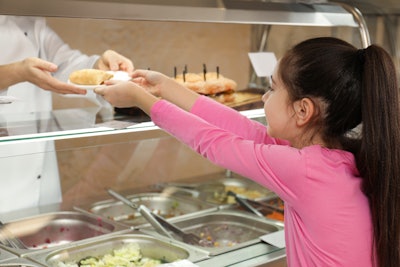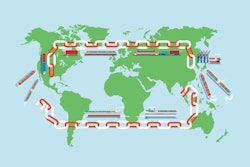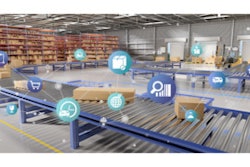
2021 was full of supply chain disruptions. From natural disasters and ransomware attacks to ships stuck at sea and a global pandemic that just won’t go away, the supply chain industry went from being upended to somewhat mended to now trying to overcome bottlenecks amid a workforce shortage.
But, it’s important to understand that supply chain disruptions will always occur, pandemic or not, just in different ways, forms and times.
In Food Logistics’ Jan/Feb 2022 issue, editor-in-chief Marina Mayer talks with several industry experts about how to mitigate supply chain threats for tomorrow and beyond.
Here’s an interview with Linda Mallers, CEO and president of MaetaData, formerly FarmLogix, LLC, who details why not all threats originate from logistics and how technology delivers the analytics and insights needed to plan ahead, with excerpts publishing in Food Logistics’ Jan/Feb 2022 issue. [CLICK HERE to read the article in full].
Food Logistics: 2021 was full of supply chain disruptions, i.e., natural disasters, global pandemic, ransomware attacks, ships stuck at sea and more. Heading into the New Year, what are some other disruptions you see posing threats to our nation’s cold food and beverage supply chains? And, why?
Linda Mallers: As a supply chain technology solution for foodservice management and distribution, we see foodservice supply instability continuing into 2022. This will have the greatest impact on K12 cafeteria supply chains for two reasons.
One, school meals are reimbursable by the USDA, which brings regulated nutritional standards to meal portioning and preparation. As schools emerged from closures, attendance was unpredictable and cautious manufacturers greatly curbed supply of compliant ingredients.
Adding to this complexity are the inherent economics and formal bid structure for school business. Historically, schools have relied on large distributors who offer extensive urban and rural route density. However, while schools have many students to feed, smaller schools have modest delivery volumes and schools across the board yield lower margins compared with restaurants. As distributors continue to struggle with labor shortages, rising fuels costs, and unpredictable demand and manufacturing, we are seeing skipped or partial K12 school deliveries. Some distributors are shifting their business models and relinquishing their K12 business entirely.
The pandemic made the health disparity in our nation abundantly clear, and the lack of stability in the delivery of school meals, often the healthiest meal of the day in low access communities, will only widen this gap. Fortunately, we are already seeing flexibility with USDA school meal standards relaxing while supply chains work to stabilize and states proactively explore supply chain alternatives.
Long term, this will undoubtedly bring permanent changes in school food supply chains and will require more diverse sourcing and delivery relationships with less reliance on single delivery and production sources. In Higher Ed, there were similar, although related, supply chain challenges where students were utilizing meal delivery apps that integrated with meal cards when cafeterias were closed. This alternative campus supply chain met a need, but also created instability for distributors, increased traffic and emissions on campuses, and created general congestion from the 1:1 delivery ratio of meal delivery apps that is not sustainable.
Food Logistics: How do the supply chain disruptions of 2020 and 2021 differ (or are similar) from what to expect in 2022?
Mallers: In 2020 and 2021, we saw supply chain issues related to the pandemic itself, including many restaurants struggling just to survive and campuses, schools and workplaces closed. When they did open, cafeterias were still closed or opened with limited capacity and hours. For the first time in generations, consumers couldn’t secure basic items, and retail grocery sales rose exponentially. So, we saw distributors filling trucks for grocery retailers to replace their restaurant business as the supply chain space saw participants quite literally deviating from their lanes.
From a technology standpoint, there is also always risk of piracy when supply chains and labor are in flux and supply and demand instability take all of our focus. We saw serious hacking attempts in the industry as we all focused on what was right in front of us. Zoom meetings replacing live meetings and companies downsized and relied on contractors, which made the supply chain vulnerable to hackers and others with malintent. From a technology standpoint this has been a bit precarious for the industry, but will diminish in 2022 as we return to the office.
2022 will bring other issues as volume picks up and the economy recovers. Even the largest companies, cafeterias, and distributors alike, saw the benefit of diversifying their supply chains in 2020 and 2021, so we will most likely never go back to how things were. That being said, we are also not at all certain as to what “next” looks like, and 2022 will most likely entail the road to next with more than a few potholes.
We anticipate continued supply/demand instability and reinvention that will differ by distributor and customer. At the same time, there is an opportunity for the supply chain as a whole to embrace innovation in logistical efficiency, as well as more local and regional sourcing. Those that survived 2020-21 have the opportunity to thrive if they are willing to shed prior inflexible operations, services, and relationships and embrace the ability to be more agile.
Food Logistics: What are some things the cold food and beverage industry can do right now to mitigate supply chain threats throughout the chain? I.e., Implement technology, etc. Please be specific.
Mallers: We are seeing many inspiring changes to mitigate supply chain threats and all utilize technology.
At the state level, we have received inquiries to utilize our marketplace technology to map and populate the marketplace with suppliers who can be discovered and matched by product need, location, logistics, and food safety protocols to diversify sources and bring supply-side stability.
For example, state lawmakers in Wisconsin and the state superintendent recently introduced the Healthy School Meals for All Act. During the pandemic, school lunches became free for all public school students, and now advocates are hoping to make the change permanent. Lawmakers say the legislation would also be an investment in local farmers. Clearly, the sourcing around this program would require technology, as would the balance between supplier diversity and USDA and FDA compliance. More importantly, effective private/public partnerships will be crucial to any state program aimed at creating economic and supply chain stability.
Not all of the threats originate from logistics. During the pandemic and two years of social awareness, the consumer voice has become louder, demanding more transparency. This requires a traditionally inflexible supply chain to become agile as it must meet shifting consumer trends and demands. Making sure purchasing decisions resonate with diners or help win/retain business is essential. Again, technology that delivers analytics and insights is key.
Food Logistics: What advice do you have for those companies still struggling to mitigate supply chain threats?
Mallers: Explore options with your distributor to make your supply chain more diverse so that you have options. This includes not just local and regional options, but backup options to traditional single sources for product. Also, don’t be an island. Reach out to other buyers in your community as to how you can pool your demand or share resources so that you participate together in the supply chain as a larger customer, alleviating minimums or extra delivery fees. We have seen some innovative distribution models to keep supply chains flexible. We also have seen smaller customers joining the volume of larger ones along a delivery route. Large customers provide anchor tenancy to support smaller customers.
As a distributor, the most challenging hurdle is balancing FDA food safety compliance with supply chain diversity and regional sourcing. Expansion of sourcing options includes managing the compliance of many more sources, which brings greater administrative and resourcing needs during a time when labor is not easy to come by.
Technology is critical to help solve for these issues, as well.
Food Logistics: What are some things not addressed above that may be pertinent to our readers regarding mitigating supply chain threats?
Mallers: It’s important to note that there are positives in change and disruption, and those that will benefit are small, local and regional suppliers, including farms, restaurants, producers and manufacturers, as well as processors. This will include inherently minority and women-owned businesses. Doors that were once closed are opening, and that opportunity is exciting.
[CLICK HERE to read the article in full].


















